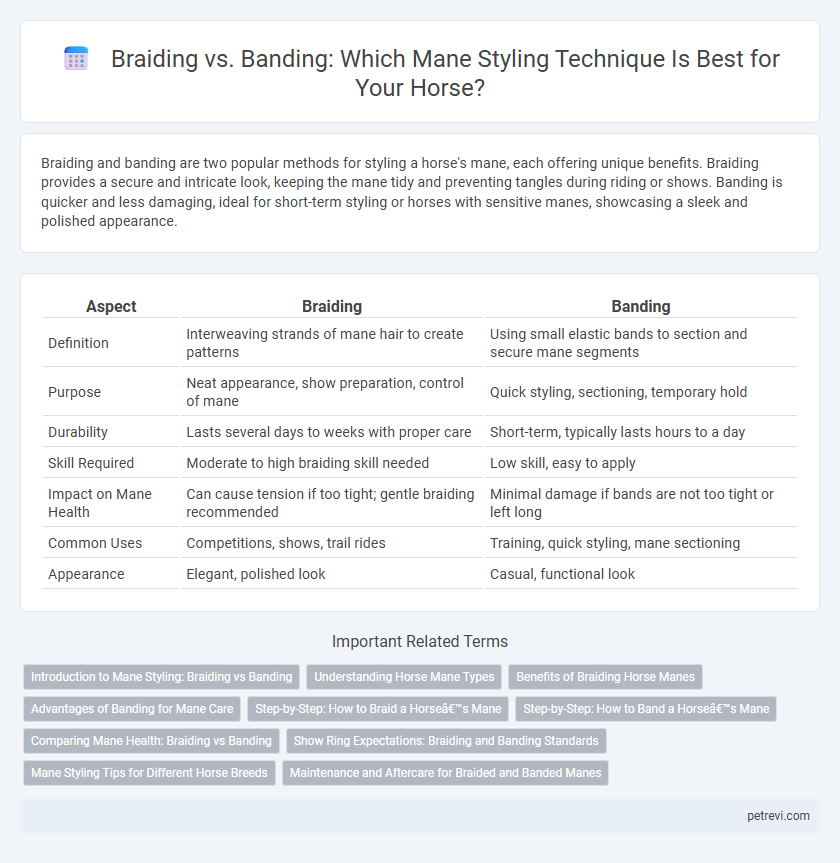Braiding and banding are two popular methods for styling a horse's mane, each offering unique benefits. Braiding provides a secure and intricate look, keeping the mane tidy and preventing tangles during riding or shows. Banding is quicker and less damaging, ideal for short-term styling or horses with sensitive manes, showcasing a sleek and polished appearance.
Table of Comparison
| Aspect | Braiding | Banding |
|---|---|---|
| Definition | Interweaving strands of mane hair to create patterns | Using small elastic bands to section and secure mane segments |
| Purpose | Neat appearance, show preparation, control of mane | Quick styling, sectioning, temporary hold |
| Durability | Lasts several days to weeks with proper care | Short-term, typically lasts hours to a day |
| Skill Required | Moderate to high braiding skill needed | Low skill, easy to apply |
| Impact on Mane Health | Can cause tension if too tight; gentle braiding recommended | Minimal damage if bands are not too tight or left long |
| Common Uses | Competitions, shows, trail rides | Training, quick styling, mane sectioning |
| Appearance | Elegant, polished look | Casual, functional look |
Introduction to Mane Styling: Braiding vs Banding
Mane styling techniques such as braiding and banding serve both functional and aesthetic purposes in horse care. Braiding involves weaving the mane into intricate patterns that help maintain a controlled and tidy appearance, ideal for competitions and shows. Banding uses small elastic bands to section and secure the mane, offering a quicker and less time-consuming alternative suitable for daily grooming and training sessions.
Understanding Horse Mane Types
Different horse mane types, such as thick, coarse manes or fine, silky strands, significantly influence the choice between braiding and banding for styling. Braiding suits horses with long, dense manes by securing hair tightly to prevent tangling during riding or shows. Banding works best for medium to fine manes, offering a quick, less invasive method that maintains mane health while providing a neat appearance.
Benefits of Braiding Horse Manes
Braiding horse manes promotes healthier hair growth by reducing breakage and tangling, while also maintaining cleanliness during riding or competition. It enhances the horse's appearance by creating a neat and polished look that highlights muscle definition along the neck. Braids are versatile and long-lasting, making them suitable for various equestrian disciplines and weather conditions.
Advantages of Banding for Mane Care
Banding for horse mane styling offers significant advantages in maintaining hair health by reducing breakage and preventing tangles compared to traditional braiding. The elastic bands create less tension on individual hairs, promoting natural growth and minimizing damage. This method allows for easy adjustments and quicker styling, making it an efficient choice for regular mane care in horses.
Step-by-Step: How to Braid a Horse’s Mane
Start by dividing the horse's mane into small, even sections to ensure uniform braids. Secure the base of each section with a tight, clear elastic band, then carefully three-strand braid the hair down to the ends, maintaining consistent tension to prevent unraveling. Finish each braid by tying it off with an elastic band and optionally twisting the braid into a neat button knot for a polished, durable style.
Step-by-Step: How to Band a Horse’s Mane
To band a horse's mane, start by thoroughly brushing the mane to remove tangles and separate it into small, even sections. Secure each section with a small, elastic band close to the base of the mane, then wrap the band upward along the hair to the desired length, creating a smooth, uniform roll. This method helps protect the hair, promotes neatness, and is less time-consuming compared to intricate braiding techniques.
Comparing Mane Health: Braiding vs Banding
Braiding a horse's mane promotes airflow and reduces dirt accumulation, minimizing the risk of skin irritation and follicle damage. Banding, while quicker, can cause tension alopecia if bands are applied too tightly or left in place for extended periods, leading to hair breakage and scalp stress. Regular care and periodic inspection are essential regardless of styling choice to maintain optimal mane health and prevent long-term damage.
Show Ring Expectations: Braiding and Banding Standards
Show ring expectations for horse mane styling emphasize strict adherence to braiding and banding standards, with braiding typically required for formal disciplines such as dressage and hunter classes. Braids should be neat, symmetrical, and tightly woven to enhance the horse's neck conformation, while banding is common in jumpers and eventing where a cleaner, less elaborate look is preferred. Judges assess the overall presentation, so precise braiding and properly sized bands reflecting breed and discipline traditions are critical for scoring success.
Mane Styling Tips for Different Horse Breeds
Braiding techniques like French or button braids provide secure styling suited for heavier manes on breeds such as Andalusians and Friesians, enhancing both function and show appearance. Banding uses small elastics to create uniform sections, ideal for breeds with finer manes like Arabians and Thoroughbreds, preventing breakage while maintaining a sleek look. Selecting the appropriate method based on mane texture and breed-specific characteristics ensures optimal comfort and style longevity.
Maintenance and Aftercare for Braided and Banded Manes
Braided manes require regular moisture application and gentle cleansing to prevent scalp irritation and maintain hair health, while banded manes need frequent inspection to avoid tightness that can cause breakage or discomfort. Both styles benefit from nightly covering with a protective hood or silk scarf to reduce friction and preserve the hairstyle. Proper aftercare ensures the horse's mane remains strong, shiny, and free from damage during styling.
Braiding vs Banding for Horse Mane Styling Infographic

 petrevi.com
petrevi.com